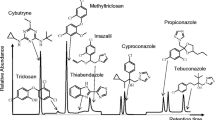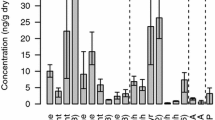Abstract
Two different analytical methods for the determination of polycyclic musk fragrances (PMFs) in wastewater and in activated sludge were developed. PMFs in filtered water samples were determined by gas chromatography coupled with a triple-quadrupole mass spectrometer in selected reaction monitoring (SRM) mode. Activated sludge samples were extracted using an ultrasonic bath and analysed using a GC-Ion trap. The developed methods respected a linear model (R2 > 0.995). Detection limits of selected compounds (Celestolide, Galaxolide, Galaxolidone, Phantolide and Tonalide) varied from 1.7 to 80 ng L−1 for water and from 0.1 ng g−1 to 210 ng g−1 for activated sludge considering laboratory contamination for each PMF. Recovery studies were performed on spiked water samples and, for sludges, on procedural blanks, showing recoveries above 70% for all the considered compounds, while recovery of the internal standard was always above limit of acceptance (30%). Proposed methods were used to determine PMFs concentrations in wastewaters and activated sludges of a wastewater treatment plant (WWTP) located in Northern Italy. Concentrations in the range of μg L−1 of Galaxolide and of its metabolite Galaxolidone were detected even in the WWTP effluent. Biotransformation of Galaxolide into Galaxolidone occurred during biological treatment with the consequent release of this compound through WWTP effluents. In activated sludges, concentrations of all PMFs except Galaxolidone were one order of magnitude higher than wastewaters, as expected according to their physicochemical properties. Present wastewater treatment technologies were confirmed to not be efficient in removing PMFs from influent wastewaters since with only ≃ 30% of Celestolide and Tonalide were removed.




Similar content being viewed by others
References
Ávila C, García J (2015) Pharmaceuticals and personal care products (PPCPs) in the environment and their removal from wastewater through constructed wetlands. Compr Anal Chem 67:195–244. https://doi.org/10.1016/B978-0-444-63299-9.00006-5
Bester K (2004) Retention characteristics and balance assessment for two polycyclic musk fragrances (HHCB and AHTN) in a typical German sewage treatment plant. Chemosphere 57:863–870. https://doi.org/10.1016/j.chemosphere.2004.08.032
Bester K (2005) Polycyclic musks in the Ruhr catchment area—transport, discharges of wastewater, and transformations of HHCB, AHTN and HHCB-lactone. J Environ Monit 7:43–51. https://doi.org/10.1039/b409213a
Bruchet A, Janex-Habibi ML (2007) Fate of anthropogenic micropollutants during wastewater treatment and influence on receiving surface water. WIT Trans Ecol Environ 103:387–397. https://doi.org/10.4491/eer.2016.115
Carballa M, Omil F, Lema JM, Llompart M, García-Jares C, Rodríguez I, Gomez M, Ternes T (2004) Behaviour of pharmaceuticals, cosmetics and hormones in a sewage treatment plant. Water Res 38:2918–2926. https://doi.org/10.1016/j.watres.2004.03.029
Chase DA, Karnjanapiboonwong A, Fang Y, Cobb GP, Morse AN, Anderson TA (2012) Occurrence of synthetic musk fragrances in effluent and non-effluent impacted environments. Sci Total Environ 416:253–260. https://doi.org/10.1016/j.scitotenv.2011.11.067
Clara M, Strenn B, Gans O, Martinez E, Kreuzinger N, Kroiss H (2005) Removal of selected pharmaceuticals, fragrances and endocrine disrupting compounds in a membrane bioreactor and conventional wastewater treatment plants. Water Res 39:4797–4807. https://doi.org/10.1016/j.watres.2005.09.015
Clara M, Gans O, Windhofer G, Krenn U, Hartl W, Braun K, Scharf S, Scheffknecht C (2011) Occurrence of polycyclic musks in wastewater and receiving water bodies and fate during wastewater treatment. Chemosphere 82:1116–1123. https://doi.org/10.1016/j.chemosphere.2010.11.041
Daughton CG, Ternes TA (1999) Pharmaceuticals and personal care products in the environment: agents of subtle change? Environ Health Perspect 107:907. https://doi.org/10.1289/ehp.99107s6907
E.C.B. (European Chemical Bureau) (2008) European Union risk assessment report. 1,3,4,6,7,8-Hexahydro-4,6,6,7,8,8-HexamethylCyclopenta-γ-2-Benzopyran(1,3,4,6,7,8-Hexahydro-4,6,6,7,8,8-Hexamethylin-Deno[5,6-C]Pyran - HHCB). http://ecb.jrc.ec.europa.eu/home.php
EU (2009) Guidance on surface water chemical monitoring under the Water Framework Directive. Guidance document No. 19. Commission implementation strategy for the Water Framework Directive (2000/60/EC). Technical report 2009-025. Available at: https://circabc.europa.eu/sd/a/e54e8583-faf5-478f-9b11-41fda9e9c564/Guidance%20No%2019%20-%20Surface%20water%20chemical%20monitoring.pdf
Everitt BS (1998) The Cambridge Dictionary of Statistics. Cambridge University Press, Cambridge, UK New York
Filipsson AF, Bard J, Karlsson S (1998) World Health Organization & International Programme on Chemical Safety. Limonene. Wissenschaftliche Verlagsgesellschaft mbH, D-70009 Stuttgart 10. WHO. ISBN 92 4 153005 7. Available at: https://www.who.int/ipcs/publications/cicad/en/cicad05.pdf?ua=1
Gao Y, Ji Y, Li G, Mai B, An T (2016) Bioaccumulation and ecotoxicity increase during indirect photochemical transformation of polycyclic musk tonalide: A modeling study. Water Res 105:47–55. https://doi.org/10.1016/j.watres.2016.08.055
Godayol A, Besalú E, Anticó E, Sanchez JM (2015) Monitoring of sixteen fragrance allergens and two polycyclic musks in wastewater treatment plants by solid phase microextraction coupled to gas chromatography. Chemosphere 119:363–370. https://doi.org/10.1016/j.chemosphere.2014.06.072
Gooding MP, Newton TJ, Bartsch MR, Hornbuckle KC (2006) Toxicity of synthetic musks to early life stages of the freshwater mussel Lampsilis cardium. Arch Environ Con Tox 51:549–558. https://doi.org/10.1007/s00244-005-0223-4
H.E.R.A. (Human and Environmental Risk Assessment on ingredients of household cleaning products) (2008) Polycyclic musks AHTN (CAS 1506-02-1) and HHCB (CAS 1222-05-05). http://www.heraproject.com/files/28-E-36551E10-F8EFE807-E4199B9BB0076A9F.pdf
He YJ, Chen W, Zheng XY, Wang XN, Huang X (2013) Fate and removal of typical pharmaceuticals and personal care products by three different treatment processes. Sci Total Environ 447:248–254. https://doi.org/10.1016/j.scitotenv.2013.01.009
Heberer T (2002) Occurrence, fate, and assessment of polycyclic musk residues in the aquatic environment of urban areas—a review. Acta Hydrochim Hydrobiol 30:227–243. https://doi.org/10.1002/aheh.200390005
Hu Z, Shi Y, Zhang S, Niu H, Cai Y (2011) Assessment of synthetic musk fragrances in seven wastewater treatment plants of Beijing, China. Bull Environ Contam Toxicol 86:302–306. https://doi.org/10.1007/s00128-011-0215-1
Joss A, Keller E, Alder AC, Göbel A, McArdell CS, Ternes T, Siegrist H (2005) Removal of pharmaceuticals and fragrances in biological wastewater treatment. Water Res, 39:3139–3152. https://doi.org/10.1016/j.watres.2005.05.031
Kupper T, Plagellat C, Brändli RC, De Alencastro LF, Grandjean D, Tarradellas J (2006) Fate and removal of polycyclic musks, UV filters and biocides during wastewater treatment. Water Res 40:2603–2612. https://doi.org/10.1016/j.watres.2006.04.012
Lee IS, Lee SH, Oh JE (2010) Occurrence and fate of synthetic musk compounds in water environment. Water Res 44:214–222. https://doi.org/10.1016/j.watres.2009.08.049
Lishman L, Smyth SA, Sarafin K, Kleywegt S, Toito J, Peart T, Lee B, Servos M, Beland M, Seto P (2006) Occurrence and reductions of pharmaceuticals and personal care products and estrogens by municipal wastewater treatment plants in Ontario, Canada. Sci Total Environ 367:544–558. https://doi.org/10.1016/j.scitotenv.2006.03.021
O.S.P.A.R. Commission (2004) Hazardous substances series, musk xylene and other musks. OSPAR Secretariat 1-904426-36-0, London, UK ISBN 1-904426-36-0
Parolini M, Magni S, Traversi I, Villa S, Finizio A, Binelli A (2015) Environmentally relevant concentrations of galaxolide (HHCB) and tonalide (AHTN) induced oxidative and genetic damage in Dreissena polymorpha. J Hazard Mater 285:1–10. https://doi.org/10.1016/j.jhazmat.2014.11.037
Poulsen TG, Bester K (2010) Organic micropollutant degradation in sewage sludge during composting under thermophilic conditions. Environ Sci Technol 44:5086–5091. https://doi.org/10.1021/es9038243
Reiner JL, Kannan K (2011) Polycyclic musks in water, sediment, and fishes from the upper Hudson River, New York, USA. Water Air Soil Pollut 214:335–342. https://doi.org/10.1007/s11270-010-0427-8
Reiner JL, Berset JD, Kannan K (2007) Mass flow of polycyclic musks in two wastewater treatment plants. Arch Environ Contam Toxicol 52:451–457. https://doi.org/10.1007/s00244-006-0203-3
Santiago-Morales J, Gómez MJ, Herrera S, Fernández-Alba AR, García-Calvo E, Rosal R (2012) Oxidative and photochemical processes for the removal of galaxolide and tonalide from wastewater. Water Res 46:4435–4447. https://doi.org/10.1016/j.watres.2012.05.051
Shek WM, Murphy MB, Lam JC, Lam PK (2008) Synthetic polycyclic musks in Hong Kong sewage sludge. Chemosphere 71:1241–1250. https://doi.org/10.1016/j.chemosphere.2007.11.069
Ternes TA, Bonerz M, Herrmann N, Löffler D, Keller E, Lacida BB, Alder AC (2005) Determination of pharmaceuticals, iodinated contrast media and musk fragrances in sludge by LC tandem MS and GC/MS. J Chromatogr A 1067:213–223. https://doi.org/10.1016/j.chroma.2004.10.096
US-EPA (2014) TSCA Work Plan Chemical Risk Assessment HHCB 1,3,4,6,7,8-Hexahydro-4,6,6,7,8,8-hexamethylcyclopenta-g-2- benzopyran. https://www.epa.gov/sites/production/files/2015-09/documents/hhcb_wp_ra_final_08_27_14.pdf
Walters E, McClellan K, Halden R (2010) Occurrence and loss over three years of 72 pharmaceuticals and personal care products from biosolids-soil mixtures in outdoor mesocosms. Water Res 44:6011–6020. https://doi.org/10.1016/j.watres.2010.07.051
Wu C, Witter JD, Spongberg AL, Czajkowski KP (2009) Occurrence of selected pharmaceuticals in an agricultural landscape, Western Lake Erie Basin. Water Res 43:3407–3416. https://doi.org/10.1016/j.watres.2009.05.014
Yang JJ, Metcalfe CD (2006) Fate of synthetic musks in a domestic wastewater treatment plant and in an agricultural field amended with biosolids. Sci Total Environ 363:149–165. https://doi.org/10.1016/j.scitotenv.2005.06.022
Zhou H, Huang X, Gao M, Wang X, Wen X (2009) Distribution and elimination of polycyclic musks in three sewage treatment plants of Beijing, China. J Environ Sci 21:561–567. https://doi.org/10.1016/s1001-0742(08)62308-6
Acknowledgements
The project was partially funded by PerFORM WATER 2030 project ID 240750 (POR FESR 2014-2020 Asse I -Accordi per la Ricerca e l'Innovazione). We like to thank SIAD Group (partner of the project) for its support in this investigation and Laura Marziali (CNR-IRSA) for her editing revision.
Author information
Authors and Affiliations
Corresponding author
Additional information
Responsible editor: Ester Heath
Publisher’s note
Springer Nature remains neutral with regard to jurisdictional claims in published maps and institutional affiliations.
Rights and permissions
About this article
Cite this article
Tasselli, S., Guzzella, L. Polycyclic musk fragrances (PMFs) in wastewater and activated sludge: analytical protocol and application to a real case study. Environ Sci Pollut Res 27, 30977–30986 (2020). https://doi.org/10.1007/s11356-019-06767-7
Received:
Accepted:
Published:
Issue Date:
DOI: https://doi.org/10.1007/s11356-019-06767-7




